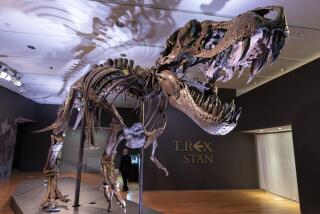Bone Yields Dinosaur DNA, Scientists Believe : Paleontology: Experts call it a historic first. But skeptics say it might be from bacterial decay instead.
In bones recovered from a cave-in at a coal mine, scientists in Utah have discovered the genes of what they believe is a dinosaur that lived 80 million years ago--an important step in the search for the chemical blueprints of awesome animals that today live on only in the popular imagination.
The genetic material is the first to be extracted directly from such ancient bones, researchers at Brigham Young University announced Thursday.
“I am confident that we have a DNA sequence that belongs to a Cretaceous period bone fragment. Based on the circumstantial evidence, we believe it is a dinosaur,” said microbiologist Scott Woodward, who led the group. “This is something that hasn’t been seen for 80 million years.”
Until recently, many scientists were certain that if such ancient molecules of DNA could be preserved, they would be found in amber--an idea that inspired Michael Crichton’s best-selling 1990 novel, “Jurassic Park.”
But the new finding, published today in the journal Science, means that scientists who hope to study the evolution of dinosaurs may be able to extract genetic material directly from remains of the extinct beasts.
The discovery is the latest advance in an unusual big game hunt for creatures that could weigh more than a herd of African elephants or top a four-story building. Biologists such as Woodward and paleontologists who usually collect fragments of fossilized femurs are now poring over laboratory gels in search of the molecular construction kit for the denizens that once dominated Earth.
The discoveries are coming at a rapid pace. In research that has not yet been published, a second group of scientists in Montana has extracted genetic material from an unusually complete and well-preserved skeleton of a six-ton Tyrannosaurus rex discovered in 1990. “We have done it three times,” said dinosaur expert Jack Horner at Montana State and the Museum of the Rockies.
“We know that ours is 65 million years old. We do have sequences, but it is still unclear whether it belongs to the dinosaur or some fungus or some bacteria or something else.”
Some experts are skeptical and suggest that the ancient DNA reconstructed by Woodward’s team may belong to ancient bacteria that flourished on the beast’s decaying bones.
“The jury is still out,” said microbiologist Raul J. Cano at Cal Poly San Luis Obispo, who has recovered genetic material from ancient insects trapped in amber 135 million years ago.
“It is probably the oldest putative ancient DNA sequence from bone,” Cano said of the new research, “but that is a long way from saying that it is a dinosaur. When you are sequencing material from a bone, you don’t know whether you are sequencing the bone itself or microorganisms that may have colonized it.
“To find any DNA at all in such ancient bone is remarkable, but we still don’t have a verified dinosaur sequence,” he said.
Woodward and his colleagues say they can make a strong case that they have discovered dinosaur DNA.
Although scientists have successfully teased DNA from insects cast in amber and even 8,000-year-old human brains, researchers had until now believed that the complex molecules were too fragile to survive in dinosaur bones for so many millions of years. In the normal process of fossilization, any organic material in bone is replaced by minerals.
Woodward’s bone chips were an exception. He said the dinosaur apparently died in a bog on the shores of an ancient inland sea and was quickly covered by peat. The geologic forces that compressed the peat into beds of coal also preserved the organic material in the delicate bones.
After two years of effort and thousands of attempts to extract DNA from the bone fragments, Woodward and his group were able to get nine genetic sequences--none of which were precisely identical.
“Only when we put them all down together did the pattern emerge which in a roundabout way says we have ancient DNA,” Woodward said.
Scientists are eager to discover and decipher dinosaur DNA because they hope to better understand how the creatures evolved. Genetic analysis would help settle a controversy over whether modern birds are descended from the dinosaurs, as some paleontologists theorize.
The DNA, or deoxyribonucleic acid, obtained from the bone is a fragment of one gene in what is called the mitochondria of a cell. Mitochondria carry on the cell’s metabolism and respiration. The genes they contain pass from mother to offspring and change at a specific rate from generation to generation, which allows researchers to use them as a kind of clock to gauge the pace of evolution.
When compared to computerized databanks of modern species, the sequences were dramatically different from the genes of any living animal--so different, in fact, that Woodward believes most dinosaurs will not fit into modern animal groups. That would mean that no creature living today is descended directly from the dinosaurs. The ancient DNA was equally distant from modern birds, reptiles or mammals.
Is science on the verge of a real-life Jurassic Park? Certainly not, experts say.
Even when more complete sequences are discovered, it is extremely unlikely that biologists could ever use the ancient genes to resurrect an extinct species of dinosaur. Even if researchers could accumulate enough genetic material--billions of properly ordered DNA units for a single organism--the technology does not exist.
The Montana group has refrained from publishing its work because, like Woodward, they cannot yet say with certainty that the ancient DNA they have isolated belongs to a dinosaur.
“There are a lot of people who have extracted DNA from dinosaur bones,” said Horner, who is supervising a group that has extracted DNA from the remains of one of the most spectacular carnivores that ever lived--a Tyrannosaurus rex.
“We are not in a race,” Horner said. “I refuse to be involved in something like that. Until we can demonstrate we have DNA from a dinosaur, none of us want to publish anything.”
But, Woodward said, “I am saying we have found it. We felt it was time to come out and say it is possible to recover DNA from bone.”






